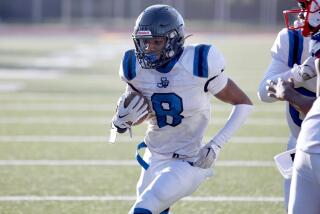After generations of failure, a school and its students head for success
- Share via
I was prepared for the dog-and-pony show — the choreographed “reveal” of a school makeover that’s been in the works for years.
I didn’t expect much beyond a grown-up version of show-and-tell. But I came anyway because I have a soft spot for Jordan High in Watts.
I’ve spent a decade tracking the school’s efforts to improve; watched reformers arrive with big plans and leave with broken dreams.
The school’s problems, they’d say, are too deep and expensive to fix; too intertwined with a neighborhood that will always be warped by dysfunction and poverty.
But on Wednesday, state schools Supt. Tom Torlakson visited the school with certificates announcing its improvement. Jordan’s 93-point jump on the state’s academic performance index was the biggest of any urban high school in California this year.
That’s why Mayor Antonio Villaraigosa showed up after working “56 hours straight” on trade missions and labor deals. “No way I’d miss this,” he said. His Partnership for Los Angeles Schools is the architect of Jordan’s reforms.
And it’s why philanthropist Melanie Lundquist, whose $50-million contribution keeps the partnership going, showed up ready to celebrate the return on her investment in this city’s struggling schools.
We spent the morning visiting classrooms, talking with teachers, oohing and aahing over pristine hallways and perfectly manicured grounds.
But what moved me most was what I heard from students on a campus that, for generations, hasn’t been able to shake its “failure” label.
“It used to be ‘Why are we here at Jordan?’,” said one 12th-grade girl. We knew what she meant:
Their school was nothing but a holding pen. Their neighborhood had been written off. Their lives would never change.
That’s how it was for years, she said. “Now everybody is seeing the change, in the school and the community.”
::
I don’t know that everybody is seeing a difference. “Change” here has been a popular but failed refrain.
Two years ago, the school was failing so persistently, it was essentially dissolved — reconstituted, in edu-speak. Its students and campus were divided between two groups, Green Dot Charter and the mayor’s Partnership for Los Angeles Schools.
Both schools on the campus posted gains this year. But the partnership’s jump — from 515 to 608 on the state’s academic performance index — surprised even its most ardent supporters.
Still, 608 isn’t scholar status; scores at the best public high schools are more than 200 points higher. And Jordan isn’t out of the woods. Its enrollment dropped this fall, after a charter school with “college” in its name opened up nearby.
The students I talked with understand that Jordan’s reputation may be its biggest hurdle. And they intend to change that by succeeding, returning as mentors and spreading the word.
“We know that we’re the ones that have to make the difference,” said senior Esmeralda Diaz. She was Student of the Month in her chemistry class — for her good work and for helping classmates with theirs.
She’s not sold on all the changes at Jordan. She misses the pep rallies, the socializing, the school spirit that disappeared when her campus was divided in half and its student body shrunk.
But students have pulled together and gotten to know each other better. Now they email about homework assignments and text each other for help.
“You see kids working on homework during lunch and nutrition,” said a senior in a UC Berkeley sweat shirt. “They care about their grades. You never used to see that back when we were freshmen and sophomores.”
Esmeralda remembers coasting through classes. “I used to not care if I got a C. That’s passing,” she said. But her teachers cared enough to push. “Now,” she said, “an A-minus isn’t good enough.”
The students gave most of the credit to their teachers, many of them young and new to Jordan.
“They actually stay after school to help,” one girl said. I heard wonder in her voice. “They give us their email so we can reach them. Teachers never used to do that. ...
“Now they’re always asking us ‘What college do you want to go to?’”
::
As our group talked with students in the library, I realized I’d never been inside that room in years of visits to Jordan.
I guess I’d spent most of my time roaming the campus looking for fights, or staking out classrooms where teachers were fumbling and kids were cutting up.
We see what we are looking for — and that sends a message to students at schools like Jordan. They know we don’t expect much of them.
I realized on Wednesday that it matters to these kids when big-wigs come to see them — even if I might write off the gestures as self-indulgent politicking.
“It makes me feel like people out there actually care for you,” said a soft-spoken girl in a Hollister jacket, who wants to be a police officer after college.
So I stifled myself and listened, while the mayor went on and on about his life story: single mom, bad grades, redemptive teacher, college, law degree, their city’s leader.
And the superintendent, a former science teacher and cross-country coach, handed out advice about setting goals and reaching them.
And the millionaire philanthropist posed the obligatory touchy-feely “How do you perceive yourself?” question.
Senior Devin Perkins, who plans to major in physics and music and play football in college, had an answer ready for that.
And when he spoke, I became a believer — at least for an instant, a teary-eyed dreamer.
There was something about the pride in his voice, the resolve in his words:
“I perceive that I can step into any university and succeed,” he said. “Don’t underestimate us.”
More to Read
Sign up for Essential California
The most important California stories and recommendations in your inbox every morning.
You may occasionally receive promotional content from the Los Angeles Times.









